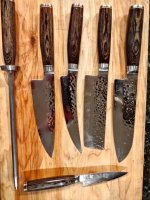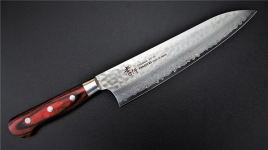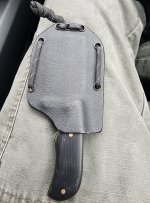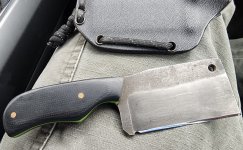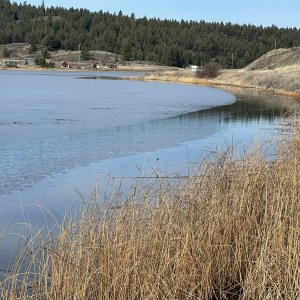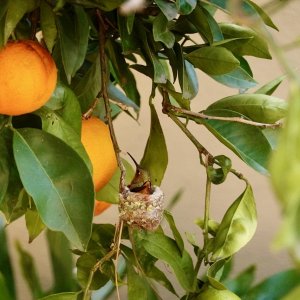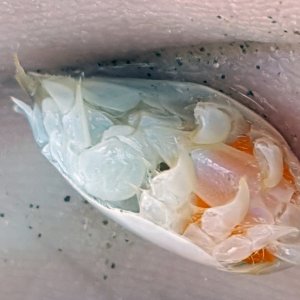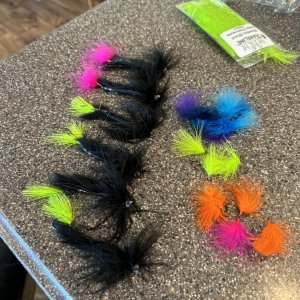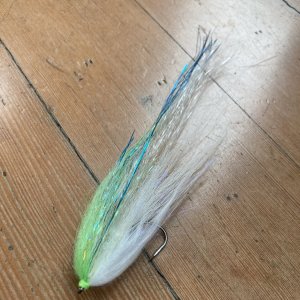Accurate and consistent angle is required for stone precision sharpening. I got decent but splurged on the KO for my Xmas present. Sharpened every knife in the house to shaving quality in no time. 20 deg for kitchen/fillet, 25 deg pocket/outdoor. Never looking back. Hurts once but easy and quick!
Navigation
Install the app
How to install the app on iOS
Follow along with the video below to see how to install our site as a web app on your home screen.
Note: This feature may not be available in some browsers.
More options
Style variation
You are using an out of date browser. It may not display this or other websites correctly.
You should upgrade or use an alternative browser.
You should upgrade or use an alternative browser.
Knife Sharpening Q's
- Thread starter DanielOcean
- Start date
The one on the left? Honestly just a cheap one I got for like $50 online somewhere like 10yrs ago. Not even sure the make or anything. It's one style knife I don't think you need to get super fancy with.What cleaver is that?
My cleaver is a 35 year old Chicago Cutlery, so I agree.The one on the left? Honestly just a cheap one I got for like $50 online somewhere like 10yrs ago. Not even sure the make or anything. It's one style knife I don't think you need to get super fancy with.
You don't need a good knife for this.Next on my wish list is a good yanagi to spice up my sushi nights
View attachment 48424
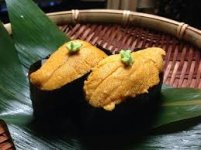
Sure don't (do love me some uni BTW) . But I need one for my endless supply of albacore loinsYou don't need a good knife for this.View attachment 48428
BriGuy
Life of the Party
As a Boy Scout in the mid 70s, I had a scoutmaster who insisted that our knives were sharp enough to shave with. Back then, we all carried Bowie knives -- the bigger the better. If our knives would not pass inspection, he would take it and sharpen it for us. He then did the shave test. Well, after a summer of us abusing our knives, he had to switch to rolling up his pant cuffs and shaving his legs because he had shaved his forearms bare.
Kind of a wacky dude, but damn were our knives sharp.
Kind of a wacky dude, but damn were our knives sharp.
A sharp knife does what you want it to. A dull one does what IT wants to.
Dull knives are more unsafe than sharp ones!
Believe me, this conversation has been had. Multiple times.
tkww
Life of the Party
One word of warning--I've had a couple of knives that just don't want to sharpen. Not sure if it's the metal in them or what. (They are definitely cheaper knives.) Point being, practicing on complete garbage might cause frustration in and of itself.I am at a loss. I am so terrible at knife sharpening its not funny. Any experienced person's out there that have good experience? I dont know what I am doing wrong. I am pretty sure this one dummy knife that I have been practicing on is completely screwed up.
Lower grit can use more pressure, higher grit usually less. Harder stone may need a little more pressure, a softer stone less. You have to use enough to develop a slurry, but too much and you're either taking off metal excessively or wearing out the stone faster. (Obviously there may be time when you want to take a lot of metal off.) Also the amount of metal (surfce area) in contact with the stone--more metal will need more pressure. If you're doing a big re-profile or thinning you may have a lot more metal in contact with the stone. If you're just trying to refine a compound bevel you would have much less metal in contact.Will slice paper and then when i try to make it sharper I lose the edge. I have no idea how much pressure I should be putting down when grinding against the stone. Should I be putting tons of pressure down or the lightest touch?
As far as losing the edge when trying to go sharper: If you can't control the angle well enough you may be destroying the edge as it gets finer and finer. Or using too much pressure?
Metal, and intended use. Look up the rockwell hardness (Rc) of your blade(s). Most western knife makers use steel with an Rc of 57 and below. What I've read is don't go beneath 18° (per side, or 36° inclusive) and skip the ultra-fine grits because the edge created won't hold up. Recommendations for kitchen use is usually between 18-21°.How the heck do I know the angle is correct when knife manufacturers use different bevel edges?
But other composites/harder metals can take thinner angles (and higher grits) if desired. I think most japanese knives are 15° and all the way down to 10° in more specialized knives. But they're also usually an Rc of 58-60 (in the mass-produced brands like Shun or Global) and specialized metals/makers going into the 60s.
As far as use: thicker is more durable but might not be as sharp (certainly won't feel as sharp). So you might sharpen a pocket knife to something like 21-24° (or more), the idea being that you want a more durable edge because of the wider variety of materials you'd cut with it compared to a kitchen knife. Meat Cleavers are often done in the 24-25 range because of bone. You might go even fatter with axe/hatchet, fatter yet with a shovel, etc. That doesn't mean they can't be very sharp, but they'll feel different than a thinner edge. But there's no hard rules here. If you're just going to open mail or slice tape with that pocket knife, feel free to go thinner. But just know that metal hardness plays a key role in how long an edge can potentially last. (And how long it will take to get sharp--harder metals take longer to sharpen.)
So as far as manufacturers all doing slightly different things--you can either try to follow the original angle, or change it to what you want. If you go thinner than what is ideal for the metal (or use), just know you'll have to sharpen it up more often. If go thicker you may get a more durable edge that doesn't have quite the sharpness. After a bit of experimenting you'll find the sweet spot of performance, durability, and maintenance.
A really important point. I have two knives (not sure why I still have them) that simply will not take a proper edge. One is over 50 years old that I bought pretty cheap in a general hardware store; the other is a Henckels type knock off that I found in a camp ground. No matter what I do they won't take an acceptable edge, although they are still sharper than the knives I encounter in most homes. I'm amazed at the crap some people have for knives.One word of warning--I've had a couple of knives that just don't want to sharpen. Not sure if it's the metal in them or what. (They are definitely cheaper knives.) Point being, practicing on complete garbage might cause frustration in and of itself.
A really important point. I have two knives (not sure why I still have them) that simply will not take a proper edge. One is over 50 years old that I bought pretty cheap in a general hardware store; the other is a Henckels type knock off that I found in a camp ground. No matter what I do they won't take an acceptable edge, although they are still sharper than the knives I encounter in most homes. I'm amazed at the crap some people have for knives.
At one point I got a free Opinel Kitchen Knife set from work (chef, fillet and pairing knives_. I didn't really need this set, and while it's perfectly serviceable it's not nearly as nice as my knives I currently have. So I fashioned a little knife roll and threw it in with our travel gear. Specifically, they're used when we go to cabins and airbnbs when we plan to cook. Nowhere is there worse knives than airbnbs and "family cabins".
oh god... the cabin I stayed at near Tillamook for winter steelheading last winter had knives that were better used as clubs. Thankfully I thought to bring one of my knives from home, or I would've had a real bad time.At one point I got a free Opinel Kitchen Knife set from work (chef, fillet and pairing knives_. I didn't really need this set, and while it's perfectly serviceable it's not nearly as nice as my knives I currently have. So I fashioned a little knife roll and threw it in with our travel gear. Specifically, they're used when we go to cabins and airbnbs when we plan to cook. Nowhere is there worse knives than airbnbs and "family cabins".
oh god... the cabin I stayed at near Tillamook for winter steelheading last winter had knives that were better used as clubs. Thankfully I thought to bring one of my knives from home, or I would've had a real bad time.
It was a game changer when we did this. We stay at a lot of airbnbs, cabins, yurts and state park cabins and this was key to making a good meal (plus replacing the 1lb propane cans with a reusable 5lb tank for our Camp Chef).
Buzzy
I prefer to call them strike indicators.
Thread drift: We’re staying in a (airbnb) cottage. I’ve seen sharper butter knives.A really important point. I have two knives (not sure why I still have them) that simply will not take a proper edge. One is over 50 years old that I bought pretty cheap in a general hardware store; the other is a Henckels type knock off that I found in a camp ground. No matter what I do they won't take an acceptable edge, although they are still sharper than the knives I encounter in most homes. I'm amazed at the crap some people have for knives.
Recieved my work sharp sharpener. Thanks for all the kind words. Lets keep talking knives though. I have been a very modest collector all my life. Have never really had anything nice though.
A
Anonymous member 148
Guest
Those some tactical pants ya got there?I know a few knife makers and usually end up with a special knife every year. Sitting here in the car waiting for my Dr appointment I found my wife's mini cleaver in the door. Made by earth crack knives. I think I'll have him make me a heavy duty full sized cleaver this year.
View attachment 48520
View attachment 48521
Trying to sharpen a blade of inferior steel is like pissing in a headwindOne word of warning--I've had a couple of knives that just don't want to sharpen. Not sure if it's the metal in them or what. (They are definitely cheaper knives.) Point being, practicing on complete garbage might cause frustration in and of itself.
Lower grit can use more pressure, higher grit usually less. Harder stone may need a little more pressure, a softer stone less. You have to use enough to develop a slurry, but too much and you're either taking off metal excessively or wearing out the stone faster. (Obviously there may be time when you want to take a lot of metal off.) Also the amount of metal (surfce area) in contact with the stone--more metal will need more pressure. If you're doing a big re-profile or thinning you may have a lot more metal in contact with the stone. If you're just trying to refine a compound bevel you would have much less metal in contact.
As far as losing the edge when trying to go sharper: If you can't control the angle well enough you may be destroying the edge as it gets finer and finer. Or using too much pressure?
Metal, and intended use. Look up the rockwell hardness (Rc) of your blade(s). Most western knife makers use steel with an Rc of 57 and below. What I've read is don't go beneath 18° (per side, or 36° inclusive) and skip the ultra-fine grits because the edge created won't hold up. Recommendations for kitchen use is usually between 18-21°.
But other composites/harder metals can take thinner angles (and higher grits) if desired. I think most japanese knives are 15° and all the way down to 10° in more specialized knives. But they're also usually an Rc of 58-60 (in the mass-produced brands like Shun or Global) and specialized metals/makers going into the 60s.
As far as use: thicker is more durable but might not be as sharp (certainly won't feel as sharp). So you might sharpen a pocket knife to something like 21-24° (or more), the idea being that you want a more durable edge because of the wider variety of materials you'd cut with it compared to a kitchen knife. Meat Cleavers are often done in the 24-25 range because of bone. You might go even fatter with axe/hatchet, fatter yet with a shovel, etc. That doesn't mean they can't be very sharp, but they'll feel different than a thinner edge. But there's no hard rules here. If you're just going to open mail or slice tape with that pocket knife, feel free to go thinner. But just know that metal hardness plays a key role in how long an edge can potentially last. (And how long it will take to get sharp--harder metals take longer to sharpen.)
So as far as manufacturers all doing slightly different things--you can either try to follow the original angle, or change it to what you want. If you go thinner than what is ideal for the metal (or use), just know you'll have to sharpen it up more often. If go thicker you may get a more durable edge that doesn't have quite the sharpness. After a bit of experimenting you'll find the sweet spot of performance, durability, and maintenance.
A
Anonymous member 148
Guest
Wranglers with cargo pockets hahaThose some tactical pants ya got there?

